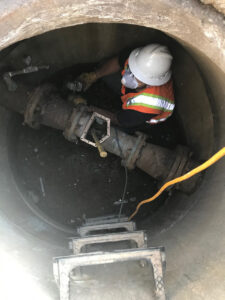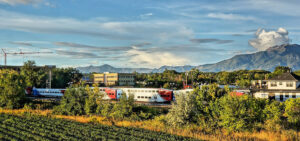Weber Basin Water Conservancy District (WBWCB) is the regional water supplier within the Ogden and Weber River drainage areas, supplying water to 700,000 people within five counties in Utah. WBWCD delivers approximately 230,000 acre-feet a year of wholesale municipal, agricultural, irrigation, and industrial water through a system including seven large storage reservoirs, three hydropower generation plants, four water treatment plants, and hundreds of miles of canals, tunnels, aqueducts, and pipelines. In this interview, Tage Flint, WBWCD’s general manager and CEO, tells Municipal Water Leader about what the district has been doing to continue operations during the pandemic.
Municipal Water Leader: Please tell us about yourself and about WBWCD.
Tage Flint: I’m the general manager of WBWCD. We’re the wholesale water utility for the northern counties of Utah. We serve about 700,000 people in five counties and are the sponsor of the Weber Basin Project, which is a Bureau of Reclamation project from the 1950s and 1960s that includes seven major dams, three hydropower plants, four drinking water treatment plants, and an extensive groundwater well and exchange system. We’re distinctive in that we supply water across the whole spectrum. We deliver drinking water as a wholesaler to about 60 cities and districts in this area. We also deliver a lot of water to industrial complexes and secondary outdoor irrigation water to urban centers. A tremendous amount of agricultural water is still delivered to agricultural centers throughout the region.
Municipal Water Leader: How many employees do you have?
Tage Flint: We have about 120 employees, including engineers, electricians, operators, human resources and administrative staff, accountants, and a robust construction maintenance team that works with heavy equipment.
Municipal Water Leader: How has the COVID‑19 pandemic affected your operations?
Tage Flint: We are an essential service, particularly since we deliver drinking water supplies to a large population. Now that it’s springtime, the agricultural businesses need water for planting as well. We have been identified as an essential service to the state of Utah, and we cannot fail in our delivery of all those water sources. About 70 percent of our staff come to work every day as usual, and about 30 percent are telecommuting, which has been an adjustment in itself. We have implemented a pandemic response plan that we’ve shared with many of the members of the National Water Resources Association over the last few months. We remain on the highest alert stage here, following extreme distancing and disinfection protocols. We are also testing employees who experience any COVID‑19 symptoms, regardless of how minor they are. The only part of our pandemic response plan that we have not implemented is the last half of the final stage, which is the sequestration of employees at sites such as drinking water treatment plants. We would have to sequester them for weeks on site so that we could ensure the continued operation of the plants without the threat of spreading the virus and causing a personnel shortage. Thankfully, we haven’t had to implement that portion of the plan so far.

Municipal Water Leader: How else are you keeping your customers and employees safe?
Tage Flint: It’s been a challenge, because the employees who are operating our facilities and control centers share keyboards, computers, touchscreens, logic controllers, and treatment plant chemical feed systems. We’ve had to implement a strict regimen of disinfection services every couple of hours and between shifts. During outdoor construction activities that require people to be in the same confined spaces, we’ve had them use N95 masks and do most things in shifts in order to keep distance from each other.
One thing that’s not talked about much is maintaining good employee morale. That has been challenging. Folks who are still required to go to work every day feel that they may be exposing their families to a higher risk. We’ve participated in seminars online and offered safety plans, and managers have been going out and visiting employees who are required to be out every day. We’ve even instituted a small cash bonus for those who are not teleworking, and I have sent them a thank-you letter acknowledging that they are heroes to the community.
Municipal Water Leader: How ready were you to facilitate telecommuting for your employees?
Tage Flint: We had our set of challenges. We had enough laptops and iPads to disperse, but we found that access to our main servers, which host our big databases, was limited. The more telecommuting users we had, the more difficult it became to access the servers. Another challenge was that our employees had home internet services of different speeds, some of which made working from home difficult. We saw both hardware and network problems at home. We have made a long list of the things that we have to correct to be better prepared next time.
Municipal Water Leader: What is the most innovative thing that you’ve done to maintain your workflow?
Tage Flint: We had to get fairly creative with our plan to sequester employees on site, which would have included all meals being brought into the treatment plant sites and arrangements for sleeping and downtime. On the computing side, it has been a challenge for our information technology (IT) staff to maintain our access to the servers while not increasing our susceptibility to hackers and computer viruses.

Municipal Water Leader: Do you expect any of the changes you have made to be retained after the pandemic is over?
Tage Flint: Yes, certainly on the IT side. There are several things that we’ve learned about server access and databases that we will change as a result of this. We’ve also learned that we can do more telecommuting than we thought we could. Some folks are as connected at home as they are at the office, maybe even more so. This came as a surprise. That may not be true across the board, but for specific positions, conditions at home allow for folks to be more efficient than in the office. We’ve also learned about how to do customer interaction with the public in a remote fashion; it has been as effective as if we were standing face to face. I’ll give you an example: One of the programs of our water conservation group includes a weekly horticulture class at our facilities for things such as landscape irrigation design or pruning trees. We now offer those classes online instead of in person, and our participant numbers have gone up.
Municipal Water Leader: What advice do you have for other agencies?
Tage Flint: Have a plan in place. I don’t know if this is true everywhere, but in our area, we got some mixed signals from state and county health officials. We serve five large counties, and each county health department had a slightly different take on what employers should do. The state gave recommendations as well. We did well in following our own planned pandemic response. We had an emergency response plan that covered all sorts of events, including a widespread illness, that we had completed about 4 years ago. We just had to fine-tune it to address this particular pandemic.
Municipal Water Leader: Was that something you created on your own, or did you have someone help you with it?
Tage Flint: Originally, we did it through a partnership with the Federal Emergency Management Agency (FEMA). The funding was provided both by the district and by FEMA. Our staff and a consultant developed it.
Municipal Water Leader: What are your plans for the future?
Tage Flint: During this experience, we are trying to identify and analyze the weaknesses in our response. We will start implementing the changes immediately thereafter to eliminate our weaknesses so that if we have another pandemic, we will be better prepared. We do not know that COVID‑19 is over; most of our health officials are worried that we might be back in this situation next fall or winter. It would be useful to have our plan shored up before then.
Tage Flint is the general manager and CEO of Weber Basin Water Conservancy District in Layton, Utah. He can be contacted by e-mail at tflint@weberbasin.com or by phone at (801) 771‑1677.
